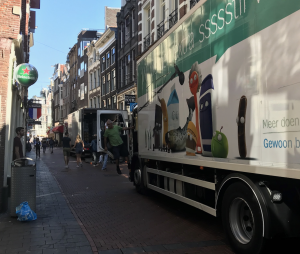Recent research helped a European retailer with the delivery of its daily goods operations. The challenge is the limited capacity of the transportation network in the Amsterdam (NL) area. This leads to very strict requirements for the delivery routing plans. In order to respond to this challenge, both an analytical model and a numerical method are proposed.
A new method is capable of generating routing plans given all the necessary constraints including the cost structure. The model takes into account all incurred costs such as mileage, unsatisfied demand and waiting times; they all are weighted according to their relative importance. Furthermore, in order to reduce waiting times, buffering locations within the Amsterdam area are considered where a truck can park and wait until the loading zone at a store becomes available.
The numerical method is approximate in nature and is based on the Column Generation technique. This technique allows iterative explorations of the search space by adding new promising one-truck routes. The Regret construction heuristic is applied to generate an initial solution. New promising columns are generated by means of solving the Pricing Sub-problem which takes into account the duals of the Master problem relaxation.
The analysis demonstrates that the buffers help to reduce the waiting times incurred by early arrivals without any drop in the total solution costs. Furthermore, a method is proposed to verify the usefulness of different buffering locations in the model. The analysis demonstrates that buffering locations help to reduce the waiting time costs without a drop in the total solution costs. Furthermore, the commonly used buffers have higher solution cost reductions than the linked buffers. In particular, these shared buffers allow savings of 7.5% of the waiting time costs and 6.9% of the total solution costs, compared to the case without buffers. The solution with cost reductions is obtained at the expense of a small increase in traveling costs.

